The Flame Nebula is a bright emission nebula located 900 – 1,500 light-years away in the constellation Orion, the Hunter. The large star-forming region has an apparent magnitude of 10. It is lit by the bright star Alnitak, the easternmost star of Orion’s Belt. The nebula has the designation NGC 2024 in the New General Catalogue.
The Flame Nebula has a radius of 6 light-years. The nebula’s hydrogen gas is ionized by the ultraviolet light of the hot, luminous supergiant star, and it glows brightly behind conspicuous bands of dark nebulosity.
The ionized hydrogen gas is responsible for producing the nebula’s distinctive red colour in optical images. The nebula is a site of active star formation, and it conceals numerous young stars and protostars that are still enshrouded in their birth clouds.
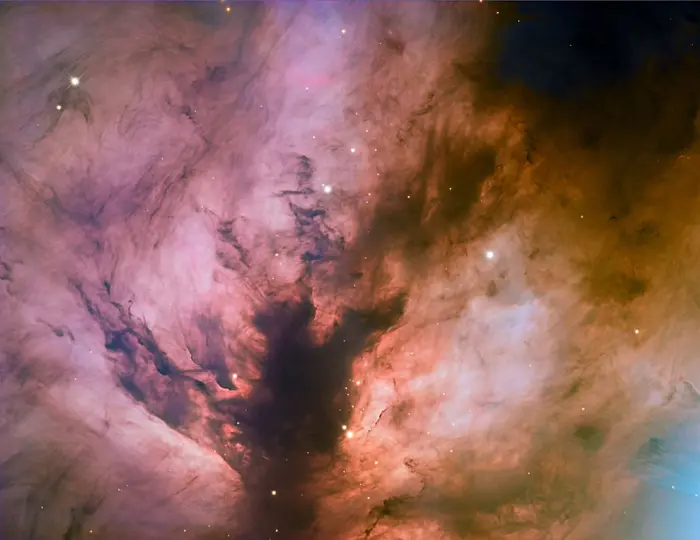
The Flame Nebula (NGC 2024), image credit: Adam Block/Mount Lemmon SkyCenter/University of Arizona (CC BY-SA 4.0)
The Flame Nebula occupies 30 arcminutes of the apparent sky and is a popular astrophotography target. It appears near the dark Horsehead Nebula and several smaller nebulae near Alnitak.
The brightest of these, the emission and reflection nebula NGC 2023, is one of the largest reflection nebulae in the sky. It appears in the area between the Flame and Horsehead nebulae. It is illuminated by the Herbig Ae/Be star (massive pre-main sequence star) catalogued as HD 37903.
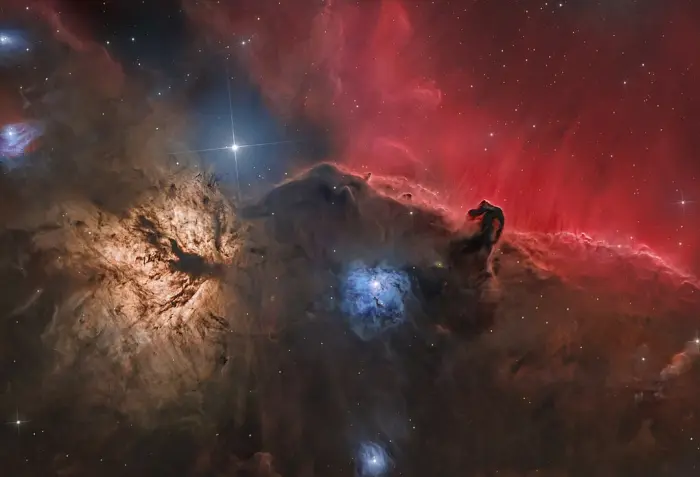
The Flame Nebula (left), the Horsehead Nebula (centre right) and NGC 2023 (centre), image credit: Wikimedia Commons/ Gianni.lacroce (CC BY-SA 4.0)
The Flame Nebula contains a young open star cluster with about 800 members. Most of these stars are newly formed. 86% of them still have circumstellar disks, from which planets may form in the future. The young cluster hosts many optically invisible protostars, embedded in their parent clouds, and young T Tauri stars that are undergoing accretion and will eventually contract onto the main sequence.
X-ray observations with the Chandra X-ray Observatory have revealed several hundred members in the cluster. These young stars emit high-energy radiation, lighting the surrounding gas and making it glow.
The youngest members of the cluster are concentrated near the cluster’s centre, while the older members lie in the outer regions. This was revealed in a study using data from NASA’s Chandra X-ray Observatory, the Spitzer Space Telescope, the United Kingdom Infrared Telescope, and the 2MASS telescope. The data showed that the stars at the cluster’s centre were only about 200,000 years old, while those in the outer regions were around 1.5 million years old.
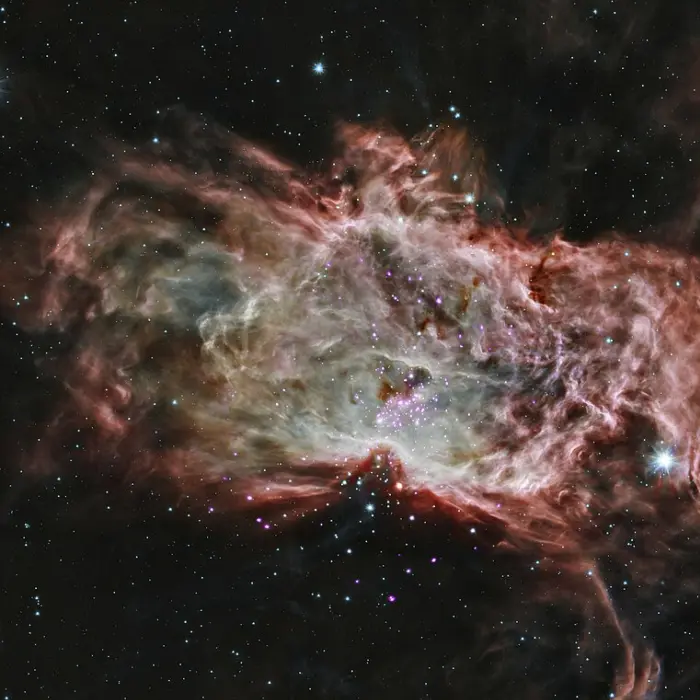
This composite image shows one of the clusters, NGC 2024, which is found in the center of the so-called Flame Nebula about 1,400 light years from Earth. In this image, X-rays from Chandra are seen as purple, while infrared data from NASA’s Spitzer Space Telescope are colored red, green, and blue. A study of NGC 2024 and the Orion Nebula Cluster, another region where many stars are forming, suggest that the stars on the outskirts of these clusters are older than those in the central regions. This is different from what the simplest idea of star formation predicts, where stars are born first in the center of a collapsing cloud of gas and dust when the density is large enough. Image credit – X-ray: NASA/CXC/PSU/K.Getman, E.Feigelson, M.Kuhn & the MYStIX team; Infrared: NASA/JPL-Caltech (PD)
There are several possible explanations for this. Star formation may be continuing to occur in the central regions of the nebula because the clouds of star forming gas are thicker there than in the outskirts. It is also possible that older stars are in the outer regions simply because they have had more time to move away from the centre.
The Flame Nebula is part of the greater Orion molecular cloud complex, a vast stellar nursery that stretches across most of the constellation Orion. The nebula lies within the Orion B molecular cloud, which also contains the emission nebula IC 434 with the Horsehead Nebula (Barnard 33), the reflection nebula Messier 78, and the variable McNeil’s Nebula, illuminated by the protostar V164 Orionis.
The larger Orion molecular cloud complex is hundreds of light-years across. It is also home to the Orion Nebula (Messier 42), De Mairan’s Nebula (Messier 43), the Running Man Nebula (Sh2-279), the Lambda Orionis molecular ring, Barnard’s Loop, and the Witch Head Nebula (IC 2118) near Rigel.
The region contains stars with ages of up to 12 million years. Some parts of the complex, such as the Orion Nebula in Orion’s Sword, are visible to the unaided eye, while others require binoculars and small telescopes.
Facts
The Flame Nebula is known by several other nicknames, including the Maple Leaf Nebula, the Burning Bush Nebula, and the Ghost of Alnitak. However, it is most commonly referred to as the Flame Nebula or NGC 2024.
The nebula is catalogued as Sharpless 277 (Sh2-277) in the Sharpless catalogue of H II regions and as LBN 953 in the Lynds’ Catalog of Bright Nebulae.
The distance to the Flame Nebula is uncertain. Many sources place it 1,350 light-years (414 parsecs) away. More recent estimates are in the range between 1,300 and 1,600 light-years.
Alnitak (Zeta Orionis) lies approximately 1,260 ± 180 light-years away. It is part of a triple star system that shines at magnitude 1.77 from this distance and is, on average, the 31st brightest stellar point of light in the sky. Alnitak is slightly fainter than the more distant Alnilam, the middle star of the Belt of Orion, and lies at a similar distance to the fainter Mintaka, the rightmost star of the Belt.
The three Orion’s Belt stars are members of the Orion OB1b subgroup of the Orion OB1 association. The subgroup includes many hot blue stars with an average age of around 8 million years.
Alnitak is a luminous blue supergiant of spectral type O9.5Iab. It is the brightest O-type star in the night sky. It has an apparent magnitude of 2.08 and has two evolved blue B-type companions that shine at magnitudes 4.28 and 4.01.
The supergiant star has 33 times the Sun’s mass and 20 times the Sun’s radius. With a surface temperature of around 29,500 K, it is 250,000 times more luminous than the Sun. It has an estimated age of only 6.4 million years.
Even though it is a young star, Alnitak has burned through its supply of hydrogen fuel quickly due to its high mass and has already evolved away from the main sequence. Stars with masses in Alnitak’s range are destined to go out as brilliant supernovae when they reach the end of their life cycles.
The two fainter companions are a B-type subgiant (B1IV) and giant (B0III). They are about 7 million years old.
The nearby Horsehead Nebula is one of the most iconic dark nebulae in the sky. It is a small cloud of dust superimposed on the star-forming H II region catalogued as IC 434. It lies at a similar distance to the Flame Nebula.
The Flame Nebula was imaged many times with different telescopes at different wavelengths. Infrared observations with ESO’s Visible and Infrared Survey Telescope for Astronomy (VISTA) at the Paranal Observatory in Chile pierced through the nebula’s thick clouds of dust to reveal the young stars that stay hidden in visible light. In December 2009, the VISTA image of the Flame Nebula was the first image captured by the survey telescope to be publicly released.
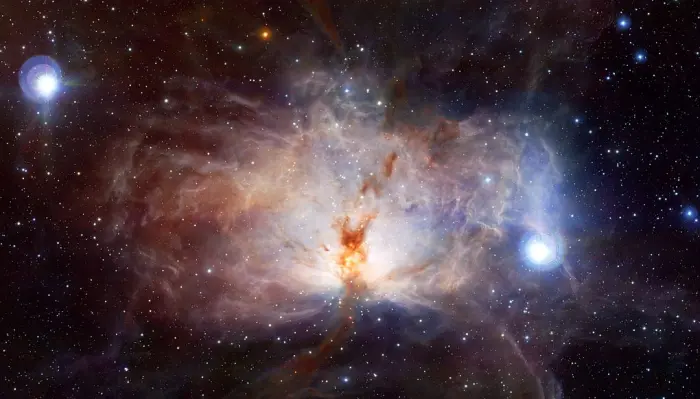
This image, the first to be released publicly from VISTA, the world’s largest survey telescope, shows the spectacular star-forming region known as the Flame Nebula, or NGC 2024, in the constellation of Orion (the Hunter) and its surroundings. In views of this evocative object in visible light the core of the nebula is completely hidden behind obscuring dust, but in this VISTA view, taken in infrared light, the cluster of very young stars at the object’s heart is revealed. The bright bluish star towards the right is one of the three bright stars forming the Belt of Orion. The image was created from VISTA images taken through J, H and Ks filters in the near-infrared part of the spectrum. Image credit: ESO/J. Emerson/VISTA; Acknowledgment: Cambridge Astronomical Survey Unit (CC BY 4.0)
In 2012, the stellar nursery was imaged with NASA’s Wide-field Infrared Survey Explorer (WISE).
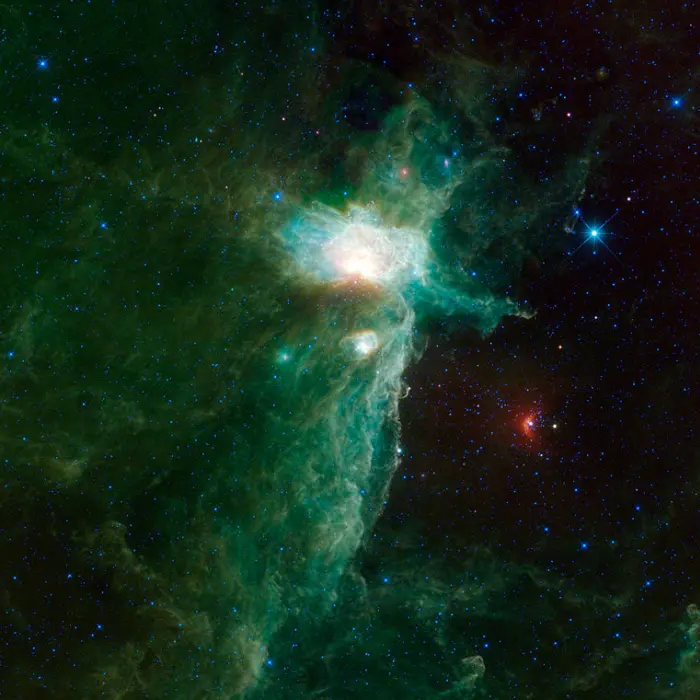
The Flame Nebula and the surrounding region by NASA’s Wide-field Infrared Survey Explorer (WISE). The bright isolated star is Alnilam. Alnitak is difficult to see within the bright nebulosity of the Flame Nebula. The Horsehead Nebula is barely visible at the centre of the image. NGC 2023 is much clearer at these wavelengths, it is the small bright patch of nebulosity just below the Flame Nebula. The red arc surrounds σ Orionis. Image credit: NASA/JPL-Caltech/UCLA
In January 2022, the European Southern Observatory (ESO) released an image of the Flame Nebula captured in the radio band with the Atacama Pathfinder Experiment (APEX) in the Atacama Desert in Chile. The observations of the surrounding area led to the discovery of a new small, circular nebula which was nicknamed the Cow Nebula.
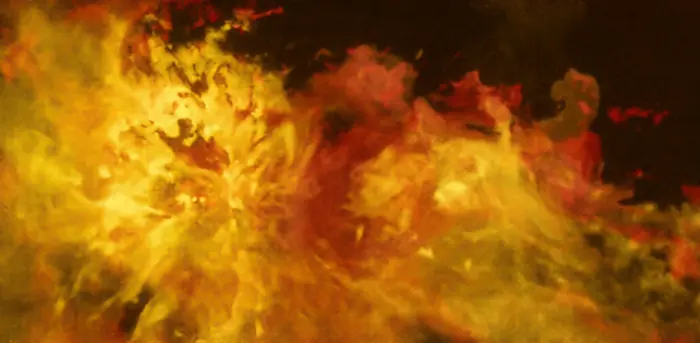
This images shows the Flame Nebula and its surroundings captured in radio waves. The image is based on observations conducted with the SuperCam instrument on the ESO-operated Atacama Pathfinder Experiment (APEX) on Chile’s Chajnantor Plateau. The Flame Nebula is the large feature on the left. The smaller feature on the right is the reflection nebula NGC 2023. To the top right of NGC 2023, the iconic Horsehead Nebula seems to emerge heroically from the “flames”. The three objects are part of the Orion cloud, a giant gas structure located between 1300 and 1600 light-years away. The different colours indicate the velocity of the gas. The Flame Nebula and its surroundings are moving away from us, with the red clouds in the background receding faster than the yellow ones in the foreground. Image credit: ESO/Th. Stanke (CC BY 4.0)
Location
The Flame Nebula is very easy to find because it lies in the region of Orion’s Belt, one of the most recognizable asterisms in the night sky. For observers in the northern hemisphere, Alnitak is the leftmost star of the Belt. The asterism lies on the celestial equator and is visible from virtually any place on Earth for at least part of the year.
Orion’s Belt is the central part of the constellation figure of the celestial Hunter. The figure of Orion looks like a crooked hourglass and is outlined by seven bright stars: Rigel, Betelgeuse, Bellatrix, Saiph, and the three stars of Orion’s Belt.
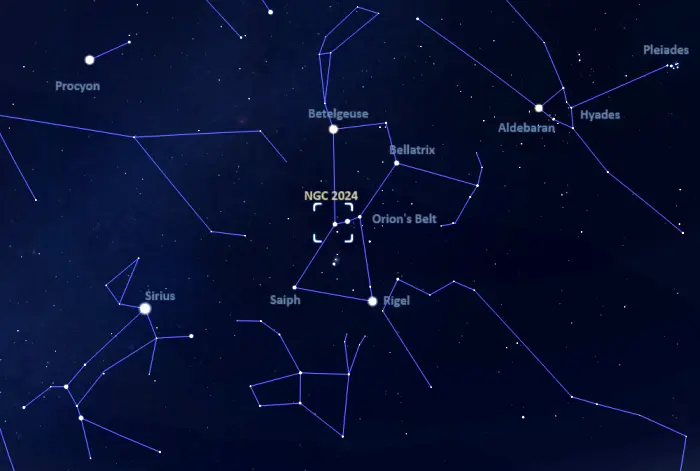
The location of the Flame Nebula (NGC 2024), image: Stellarium
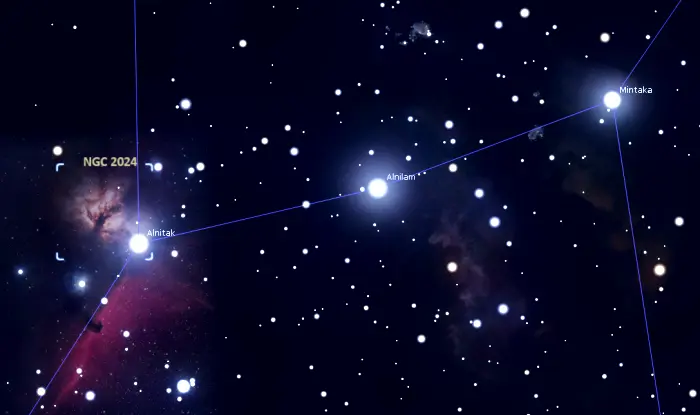
Flame Nebula location, image: Stellarium
The best time of the year to observe the Flame Nebula and other deep sky objects in Orion is during the month of January, when the constellation dominates the evening sky. Orion is easily observed from November to February.
Flame Nebula – NGC 2024
| Constellation | Orion |
| Right ascension | 05h 41m 42.7s |
| Declination | −01° 54′ 44″ |
| Apparent magnitude | 10 |
| Apparent size | 30’ x 30’ |
| Distance | 1,350 light-years (415 parsecs) |
| Radius | 6 light-years |
| Names and designations | Flame Nebula, NGC 2024, Sharpless 277 (Sh2-277), LBN 953, LBN 206.90-16.56, SNR G206.5-16.4, W 12 |
Images
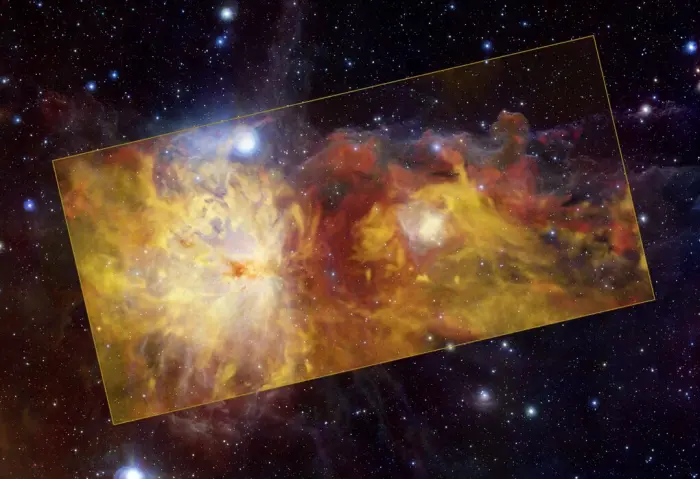
Do not let the image and the name of the depicted cosmic object fool you! What you see in this picture is not a wildfire, but the Flame Nebula and its surroundings captured in radio waves.The Flame Nebula is the large feature on the left half of the central, yellow rectangle. The smaller feature on the right is the reflection nebula NGC 2023. To the top right of NGC 2023, the iconic Horsehead Nebula seems to emerge heroically from the “flames”. The three objects are part of the Orion cloud, a giant gas structure located between 1300 and 1600 light-years away.The different colours indicate the velocity of the gas. The Flame Nebula and its surroundings are moving away from us, with the red clouds in the background receding faster than the yellow ones in the foreground.The image in the rectangle is based on observations conducted with the SuperCam instrument on the ESO-operated Atacama Pathfinder Experiment (APEX) on Chile’s Chajnantor Plateau. The background image was taken in infrared light with ESO’s Visible and Infrared Survey Telescope for Astronomy (VISTA) at the Paranal Observatory in Chile. Image credit: ESO/Th. Stanke & ESO/J. Emerson/VISTA. Acknowledgment: Cambridge Astronomical Survey Unit (CC BY 4.0)
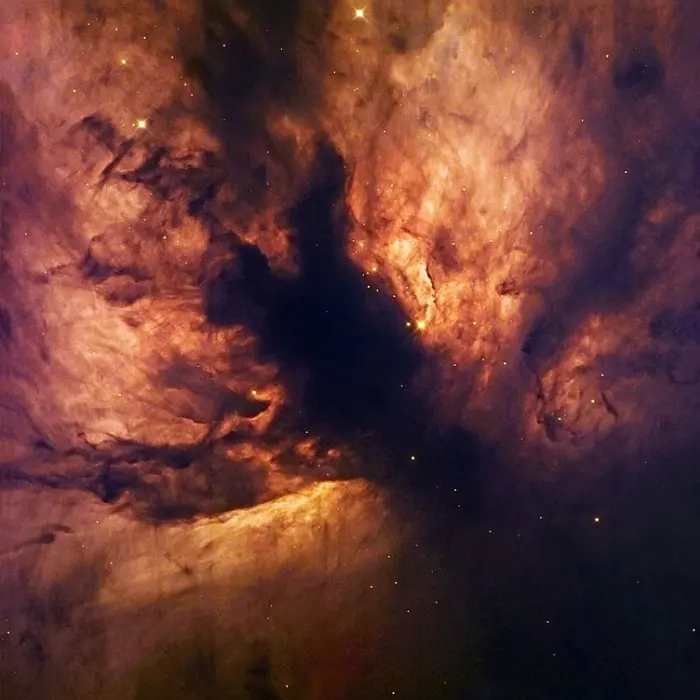
Sparkling at the edge of a giant cloud of gas and dust, the Flame Nebula, also referred to as NGC 2024, is in fact the hideout of a cluster of young, blue, massive stars, whose light sets the gas ablaze. Located 1300 light-years away towards the constellation of Orion, the nebula owes its typical colour to the glow of hydrogen atoms, heated by the stars. The latter are obscured by a dark, forked dusty structure in the centre of the image and are only revealed by infra-red observations. Image credit: ESO/IDA/Danish 1.5 m/R. Gendler, J.-E. Ovaldsen, C. Thöne and C. Féron (CC BY 4.0)
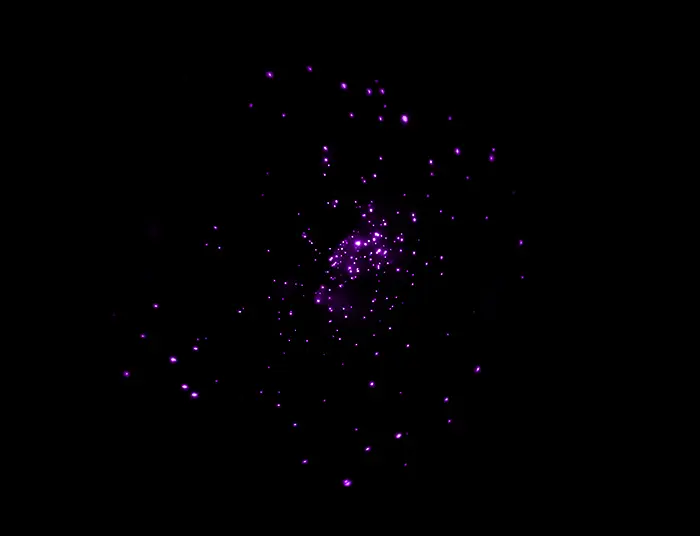
Flame Nebula by the Chandra X-ray Observatory, image credit: NASA/CXC/PSU/K.Getman, E.Feigelson, M.Kuhn & the MYStIX team
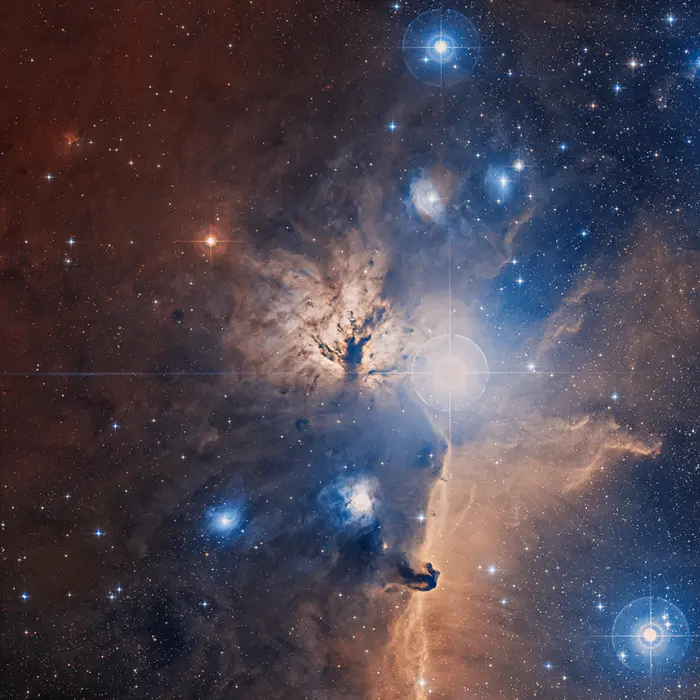
This spectacular visible light wide-field view of part of the famous belt of the great celestial hunter Orion shows the region of the sky around the Flame Nebula. The whole image is filled with glowing gas clouds illuminated by hot blue young stars. It was created from photographs in red and blue light forming part of the Digitized Sky Survey 2. The field of view is approximately three degrees. Image credit: ESO and Digitized Sky Survey 2 (CC BY 4.0)
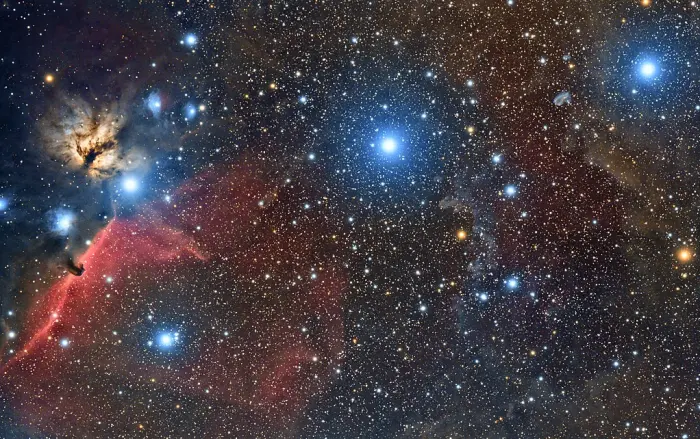
The Flame Nebula and Orion’s Belt, image credit: Wikimedia Commons/Keesscherer (CC BY-SA 4.0)
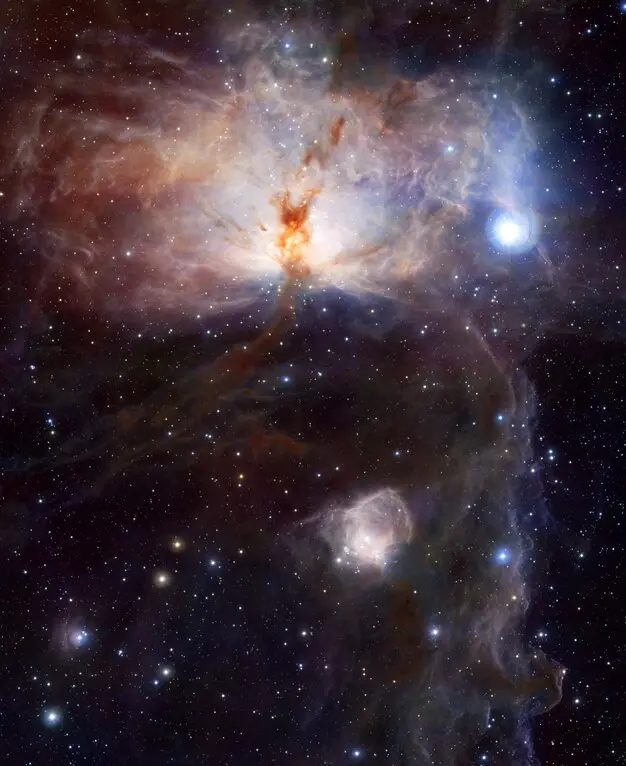
The wide-field VISTA view of the Flame Nebula also includes the glow of the reflection nebula NGC 2023, just below centre, and the ghostly outline of the Horsehead Nebula (Barnard 33) towards the lower right. The bright bluish star towards the right is one of the three bright stars forming the Belt of Orion. The image was created from VISTA images taken through J, H and Ks filters in the near-infrared part of the spectrum. The image shows the full area of the VISTA field and is one degree by 1.5 degrees in extent. The total exposure time was 14 minutes. Image credit: ESO/J. Emerson/VISTA. Acknowledgment: Cambridge Astronomical Survey Unit (CC BY 4.0)